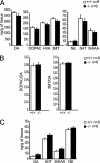Altered dopamine signaling and MPTP resistance in mice lacking the Parkinson's disease-associated GPR37/parkin-associated endothelin-like receptor
- PMID: 15218106
- PMCID: PMC454186
- DOI: 10.1073/pnas.0403661101
Altered dopamine signaling and MPTP resistance in mice lacking the Parkinson's disease-associated GPR37/parkin-associated endothelin-like receptor
Abstract
GPR37 is an orphan G protein-coupled receptor expressed in mammalian brain, and its insoluble aggregates are found in the brain samples of juvenile Parkinson's disease patients. We have produced a Gpr37 knock-out mouse strain and identified several phenotypic features that are similar to those reported for mutants of genes encoding components of synaptic dopamine vesicles. Our results reveal an unanticipated role of GPR37 in regulating substantia nigra-striatum dopaminergic signaling. Gpr37(-/-) mice are viable, with normal brain development and anatomy, but they exhibit reduced striatal dopamine content, enhanced amphetamine sensitivity, and specific deficits in motor behavior paradigms sensitive to nigrostriatal dysfunction. These functional alterations are not associated with any substantial loss of substantia nigra neurons or degeneration of striatal dopaminergic afferences, the main histological marks of Parkinson's disease. The inactivation of GPR37, in fact, has protective effects on substantia nigra neurons, causing resistance to treatment with the Parkinsonian neurotoxin 1-methyl-4-phenyl-1,2,3,6-tetrahydropyridine.
Figures






References
-
- Marazziti, D., Golini, E., Magrelli, A., Matteoni, R. & Tocchini-Valentini, G. P. (2001) Curr. Genomics 2, 253-260.
-
- Marazziti, D., Golini, E., Gallo, A., Lombardi, M. S., Matteoni, R. & Tocchini-Valentini, G. P. (1997) Genomics 45, 68-77. - PubMed
-
- Marazziti, D., Gallo, A., Golini, E., Matteoni, R. & Tocchini-Valentini, G. P. (1998) Genomics 53, 315-324. - PubMed
-
- Zeng, Z., Su, K., Kyaw, H. & Li, Y. (1997) Biochem. Biophys. Res. Commun. 233, 559-567. - PubMed
-
- Leng, N., Gu, G., Simerly, R. B. & Spindel, E. R. (1999) Brain Res. Mol. Brain Res. 69, 73-83. - PubMed
Publication types
MeSH terms
Substances
LinkOut - more resources
Full Text Sources
Other Literature Sources
Molecular Biology Databases

